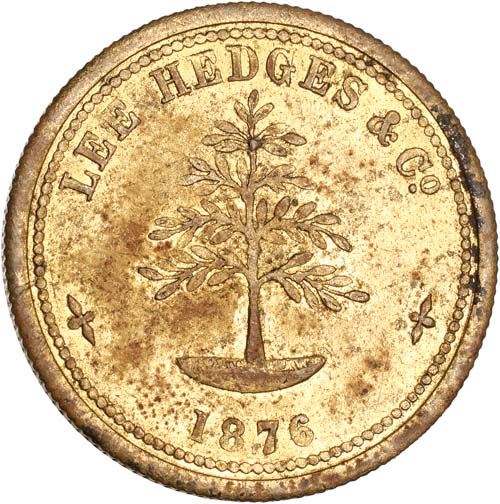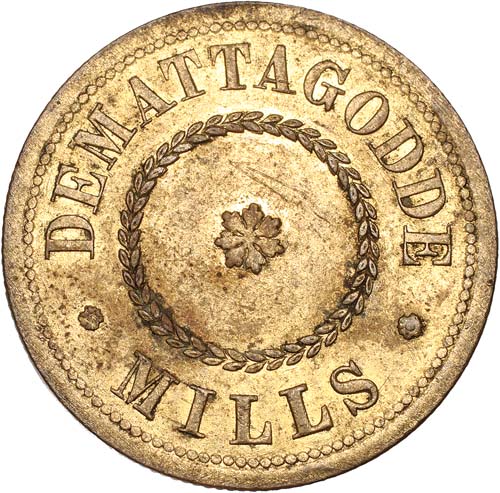| SPECIFICATIONS | |
| Denomination | 18 cents |
| Alloy | Brass |
| Diameter | 29.0 mm |
| Thickness | 1.8 mm |
| Weight | 8.65 gms |
| Shape | Round |
| Edge | Milled |
| Die Axis | 0° |
| Issue | |


|

|

| ||||||||||||||||||||
| Lowsley #8 Pridmore #62 | ||||||||||||||||||||||
| Obverse : | Centered Flower within wreath | DEMATTAGODDE * MILLS * | along periphery in beaded circle inside raised rim. |
| Reverse: | Centered tea-bush | LEE,HEDGES,&CO. * 1876 * | along periphery in beaded circle inside raised rim. |
LEE, HEDGES & Co. The inception of this firm dates back to
1857 when W. D. Lee started business in Colombo for Brice and Boustead
of London. In 1866 he admitted J. R. Hedges as partner and from that
year the firm became known as Lee, Hedges & Co.
On the death of Lee in 1871, G.A.M. Hedges, brother of JR. Hedges,
came into the firm but in 1877.
The firm had two Mills in Colombo. The earlier one at
Colpetty, a coffee and oil mill,
the other, the Demattagodde Coffee Mills employing about 400 hands in
Dean's Road, Maradana. In 1880 the Demattagodde Mills was closed after
the partnership was dissolved and JR. Hedges left Ceylon in 1880. The
property in 1895 was called Vavasseur & Co.'s Mills.
Reference
* Coins and Tokens
of Ceylon, Lieut. Col B. Lowsley, Num. Chron. Sr III Vol. XV, 1895.
* The Coins of British Commonwealth of Nations to the end of the
reign of George VI 1952
Part 2 - Asian Territories by F. Pridmore Spink & Son Ltd., 1965.
Tokens
The coin was scanned at 300 dpi and the images are displayed at
200 dpi.
The very fine condition coin was purchased in November 2001 from
a Collector in Pittsburgh, who had got it from William Woodside(1905-1978)
at a WPNS meeting. Bill Woodside is acknowledged as a
contributor by Pridmore in the Asian Territories Volume containing Ceylon.
Woodside's collection was gifted to the Carnegie Museum in Pittsburgh
of which he was the head volunteer curator of the coin collection.
The museum however sold that collection at a later date.